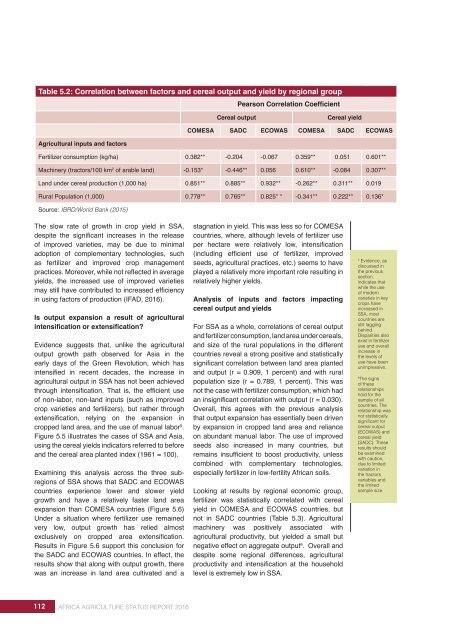AFRICA AGRICULTURE STATUS REPORT 2016
AASR-report_2016-1
AASR-report_2016-1
Create successful ePaper yourself
Turn your PDF publications into a flip-book with our unique Google optimized e-Paper software.
Table 5.2: Correlation between factors and cereal output and yield by regional group<br />
Pearson Correlation Coefficient<br />
Cereal output<br />
Cereal yield<br />
COMESA SADC ECOWAS COMESA SADC ECOWAS<br />
Agricultural inputs and factors<br />
Fertilizer consumption (kg/ha) 0.382** -0.204 -0.067 0.359** 0.051 0.601**<br />
Machinery (tractors/100 km 2 of arable land) -0.153* -0.446** 0.056 0.610** -0.084 0.307**<br />
Land under cereal production (1,000 ha) 0.851** 0.885** 0.932** -0.262** 0.311** 0.019<br />
Rural Population (1,000) 0.778** 0.765** 0.825* * -0.341** 0.222** 0.136*<br />
Source: IBRD/World Bank (2015)<br />
The slow rate of growth in crop yield in SSA,<br />
despite the significant increases in the release<br />
of improved varieties, may be due to minimal<br />
adoption of complementary technologies, such<br />
as fertilizer and improved crop management<br />
practices. Moreover, while not reflected in average<br />
yields, the increased use of improved varieties<br />
may still have contributed to increased efficiency<br />
in using factors of production (IFAD, <strong>2016</strong>).<br />
Is output expansion a result of agricultural<br />
intensification or extensification?<br />
Evidence suggests that, unlike the agricultural<br />
output growth path observed for Asia in the<br />
early days of the Green Revolution, which has<br />
intensified in recent decades, the increase in<br />
agricultural output in SSA has not been achieved<br />
through intensification. That is, the efficient use<br />
of non-labor, non-land inputs (such as improved<br />
crop varieties and fertilizers), but rather through<br />
extensification, relying on the expansion in<br />
cropped land area, and the use of manual labor 5 .<br />
Figure 5.5 illustrates the cases of SSA and Asia,<br />
using the cereal yields indicators referred to before<br />
and the cereal area planted index (1961 = 100).<br />
Examining this analysis across the three subregions<br />
of SSA shows that SADC and ECOWAS<br />
countries experience lower and slower yield<br />
growth and have a relatively faster land area<br />
expansion than COMESA countries (Figure 5.6)<br />
Under a situation where fertilizer use remained<br />
very low, output growth has relied almost<br />
exclusively on cropped area extensification.<br />
Results in Figure 5.6 support this conclusion for<br />
the SADC and ECOWAS countries. In effect, the<br />
results show that along with output growth, there<br />
was an increase in land area cultivated and a<br />
stagnation in yield. This was less so for COMESA<br />
countries, where, although levels of fertilizer use<br />
per hectare were relatively low, intensification<br />
(including efficient use of fertilizer, improved<br />
seeds, agricultural practices, etc.) seems to have<br />
played a relatively more important role resulting in<br />
relatively higher yields.<br />
Analysis of inputs and factors impacting<br />
cereal output and yields<br />
For SSA as a whole, correlations of cereal output<br />
and fertilizer consumption, land area under cereals,<br />
and size of the rural populations in the different<br />
countries reveal a strong positive and statistically<br />
significant correlation between land area planted<br />
and output (r = 0.909, 1 percent) and with rural<br />
population size (r = 0.789, 1 percent). This was<br />
not the case with fertilizer consumption, which had<br />
an insignificant correlation with output (r = 0.030).<br />
Overall, this agrees with the previous analysis<br />
that output expansion has essentially been driven<br />
by expansion in cropped land area and reliance<br />
on abundant manual labor. The use of improved<br />
seeds also increased in many countries, but<br />
remains insufficient to boost productivity, unless<br />
combined with complementary technologies,<br />
especially fertilizer in low-fertility African soils.<br />
Looking at results by regional economic group,<br />
fertilizer was statistically correlated with cereal<br />
yield in COMESA and ECOWAS countries, but<br />
not in SADC countries (Table 5.3). Agricultural<br />
machinery was positively associated with<br />
agricultural productivity, but yielded a small but<br />
negative effect on aggregate output 6 . Overall and<br />
despite some regional differences, agricultural<br />
productivity and intensification at the household<br />
level is extremely low in SSA.<br />
5<br />
Evidence, as<br />
discussed in<br />
the previous<br />
section,<br />
indicates that<br />
while the use<br />
of modern<br />
varieties in key<br />
crops have<br />
increased in<br />
SSA, most<br />
countries are<br />
still lagging<br />
behind.<br />
Disparities also<br />
exist in fertilizer<br />
use and overall<br />
increase in<br />
the levels of<br />
use have been<br />
unimpressive.<br />
6<br />
The signs<br />
of these<br />
relationships<br />
hold for the<br />
sample of all<br />
countries. The<br />
relationship was<br />
not statistically<br />
significant for<br />
cereal output<br />
(ECOWAS) and<br />
cereal yield<br />
(SADC). These<br />
results should<br />
be examined<br />
with caution,<br />
due to limited<br />
variation in<br />
the tractors<br />
variables and<br />
the limited<br />
sample size.<br />
112 <strong>AFRICA</strong> <strong>AGRICULTURE</strong> <strong>STATUS</strong> <strong>REPORT</strong> <strong>2016</strong>


